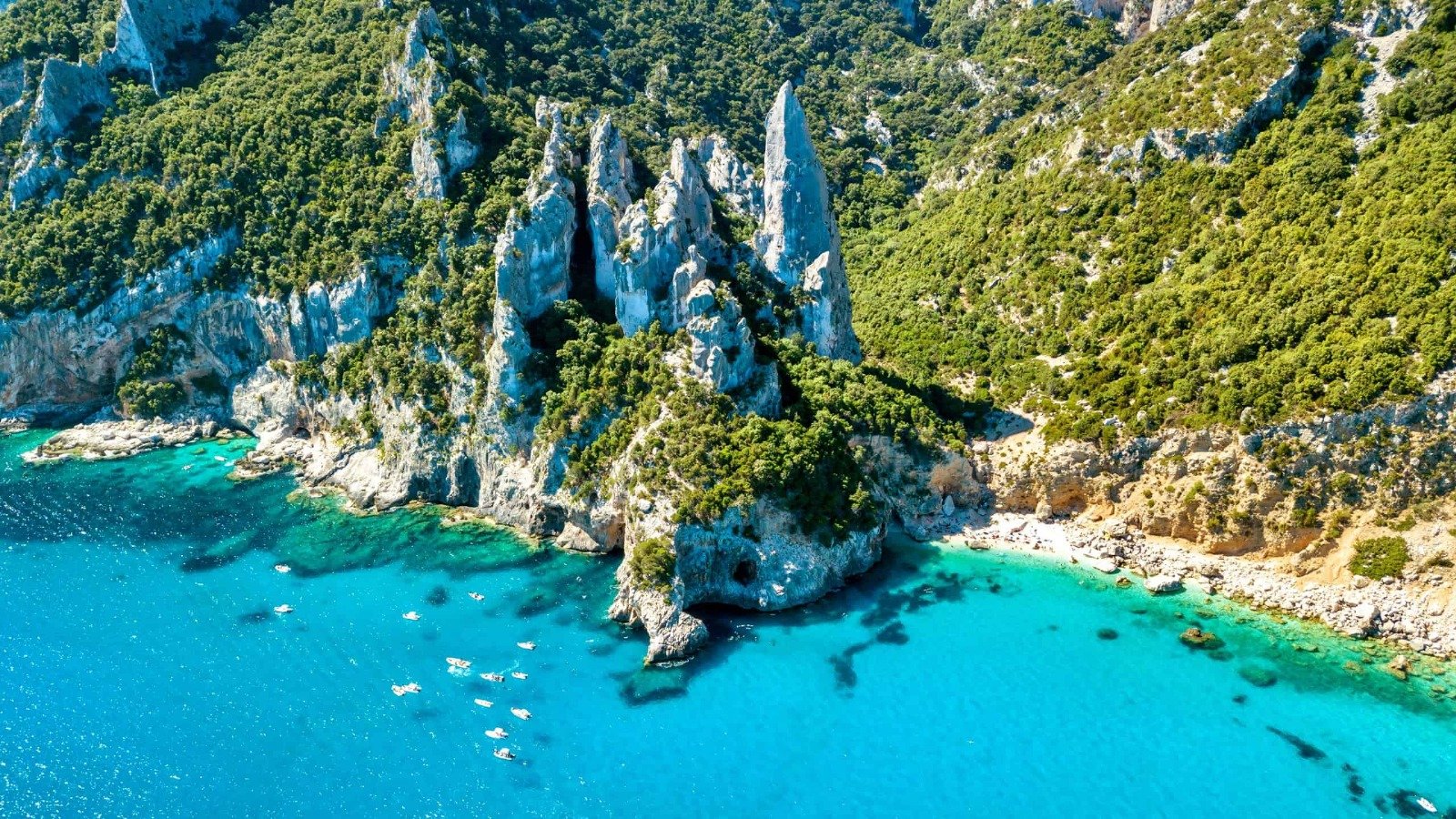Hiking Trails Must Do in Sardinia
There is a common misconception that Sardinia is best visited during summer months.
Imagine turquoise waters and white sandy beaches: With its 1,800 km long coasts, the island of Sardinia in Italy is a popular summer destination, considered by some “The Maldives of the Mediterranean Sea”.
Now add blossoming nature, mild weather and no crowds, and you’ll get Sardinia off-season.
The months of April, May and June are considered off-season in the fantastic holiday world in Sardinia.
The low season allows you to appreciate the authentic beauty of the sunny alleys, where piazzas, small squares and historic buildings stand out, or to take shelter in the shade of the oldest and most evocative alleys for a coffee break or an ice cream.
In fact, did you know that this island has so much more to offer than just beaches and luxury hotels?
If you are a nature lover, you’ll be impressed by the amount and variety of hikes in Sardinia to choose from! Here are some of our favorites:
· The Selvaggio Blu (Wild Blue) is the most famous trekking trail and one of the most challenging in Europe, a seven-day hike that entails partly climbing and via ferrata and has no refreshment points: you need to take water and food with you for the whole seven days. You will camp out at night. ‘In exchange’ you will be experiencing a journey through unspoilt nature and deep blue coves: 50 kilometres from Santa Maria Navarrese to Cala Gonone. A short hike will take you to the spectacular natural monument of Pedra Longa: the first part of the route is relaxing and the stages that follow make it an exciting and demanding mountaineering path, not recommended for hikers. The true first stage starts with the pinnacle of Pedra Longa. The fatigue of the climb - 625 metres of altitude difference - will be rewarded by the Supramonte di Baunei landscape. Along the path, you will see steps made from juniper that allow you to cross the seemingly inaccessible mountain: that known as ‘e s’Ozzastru leads to Punta Giradili. The crossing of the Gulf of Orosei covers the same areas as the Selvaggio Blu but favours the immediate hinterland: it is an easier trekking trail, although challenging. The departure and arrival are identical, and it is a five-day hike, with views of the eastern coastline.
· The Canyon of Gorropu, one of the deepest canyons in Europe, with 500-metre-high rock faces that can only be visited on foot along three paths. To the north, passing through the valley of Oddoene, in the territory of Dorgali: this is the least challenging trail and is a two-hour walk, starting from the sa Barva bridge, passing close to a torrent that created the canyon - until you reach its entrance. To the south, the trail - which can be completed in three and a half hours there and back - starts at the sheepfolds of Sedda ar Baccas, in the territory of Urzulei. The long, along a steep descent, will take you to a ‘pool’ at the foot of a drop in the river and, after that, to sa Giuntura, a junction of two rivers, the waters of which are collected in a little lake that can only be crossed with adequate equipment. After wading across the river, you will be able to reach the nuraghi of Gorropu and Mereu, two ‘giants’ made of white limestone that stand out against the greenery of the wood. The third itinerary, to the east of the canyon, starts from a parking area of state road SS 125. The trail, which takes one hour there and two hours back, is well marked out. The only difficulty is the rise. By zigzagging, you will cross some wood, filled with ferns and Mediterranean fragrances, and you will reach the entrance to Gorropu that can also be reached from sa Barva.
· The Santa Barbara mine trail. The tower, the site of the martyrdom of Saint Barbara, is the symbol of and marks, with yellow on blue, of the 500 km route of the Santa Barbara mine trail. Gravel paths, dirt roads, mule trails and abandoned railway tracks of the Sulcis, Iglesiente and Guspinese areas.
It is over this that the trail takes you as it touches dozens of sites protected by the Geo-mineral Park of Sardinia. The trails, once used by the miners, are now revitalized thanks to the Cammino and embody the spirit of the territories they go through, made up of rugged hills rich in deposits overlooking beautiful coastal stretches. The Cammino is made up of 30 stages, and in each one you will come across the ruins of mines and their melancholy abandoned villages, all competing with nature as it strives to gain the upper hand.
Here you can grasp the exhausting daily life once led by the miners as you now safely enter the bowels of the earth and walk through the tunnels dug deep into the mountain side.
It takes about a month to complete the entire loop, and we suggest you take it slowly and perhaps split it up in more than one visit, ideal in Spring or Autumn when the experience will remain imprinted on your heart and soul long after you get home.
· Cala Goloritzé hiking trail. One of the most beautiful and spectacular trails in Sardinia is undoubtedly the one that leads to Cala Goloritzè, a beach of rare beauty located not far from Baunei. Its beauty is to be preserved, which is why it is not possible to reach it directly by boat, but only to stay offshore or reach it on foot. Cala Goloritzè is the ideal place for sportsmen, as it is possible to reach it on foot along the path, but it is also a favourite destination for climbers. In fact, the Guglia has some of the most beautiful walls on the island for climbing enthusiasts.
· S’Istrada Longa. This route reveals the life of these mountains and their inhabitants, where silence, voices, shapes, and scents merge into the essence of nature.
The itinerary of S’Istrada Longa was created by shepherds who used it to migrate their goats from the seaside lands to the higher summer pastures. Their paths will guide us through woody canyons to the vast arch of S’Arcada Manna. Beyond, a narrow, exposed ledge at 100 meters high, lined with young junipers, offers breathtaking views.
S’Istrada Longa features deep canyons, massive crags, and amazing views over coastal cliffs. Century-old oaks and yew trees frame vibrant peony, foxglove, and helichrysum blooms. Above, golden eagles and kestrels soar, while hawks dive swiftly for prey.
Walking this narrow passage feels like crossing a Tibetan bridge, providing adrenaline rushes and spectacular canyon views.
· Capo Testa – Valle della Luna. One of the obligatory stages during a holiday in the North of Sardinia has to be the Capo Testa peninsula at Santa Teresa Gallura. The trekking trails in and around Capo Testa are fascinating and full of historical and botanical interest – places with a unique and unusual appeal that will bewitch hikers and outdoor enthusiasts alike. Outdoor enthusiasts will also find the Valle dell ‘Erica Resort trails exciting. Guests at the 5-star Santa Teresa Gallura Resort can take an energetic walk along the nature trail a few steps from their room, an easy route surrounded by Mediterranean vegetation and dotted with granite formations.
· Sella del Diavolo hike. The Sella del Diavolo hike is definitely one of the best hikes in Sardinia, and very easily accessible. The trailhead is in Calamosca. The beginning of the trail faces Calamosca beach, where you can see impressive views of the watchtower and lighthouse below. From the top of Sella del Diavolo, the view is expanded much wider— encompassing the Gulf of Cagliari and Poetto Beach, the most popular beach in Cagliari. This is an out-and-back-hike that is easy enough for the whole family and that can be tackled year-round, although summer months aren’t recommended.
The beauty of Sardinia lies in its ability to surprise and captivate visitors with its precious landscapes and hidden gems.
Sardinia invites you to step off the beaten path and explore its hidden wonders, creating memories that will last a lifetime.
Unveil the unexpected, embrace the extraordinary, and let this Mediterranean gem reveal its secrets to you.

